Physical Address
304 North Cardinal St.
Dorchester Center, MA 02124
Because the orbit is made up in part by two of the horizontal beams of facial structure and two of the vertical buttresses, orbital fractures are common, and proper repair of such fractures is critical to restoring normal facial appearance and function. Complicating evaluation and treatment are the vital and complex structures contained within the eye and optic nerve, extraocular muscles, and the lacrimal secretory and excretory systems. Understanding the classes of fractures involving the orbit is critical to their evaluation and prediction of other possible associated injuries. These categories will suggest a systematic approach to their treatment and repair.
The bony orbit is shaped similar to a pyramid with its apex directed posteromedially ( Figs. 187.1 and 187.2 ). The medial walls are approximately parallel, and the lateral walls diverge at approximately 90 degrees. The normal volume of an adult orbit is 30 mL. The periosteum of the orbit is also known as the periorbita, and it surrounds the orbital contents in a continuous sheet except over the various foramina and fissures.
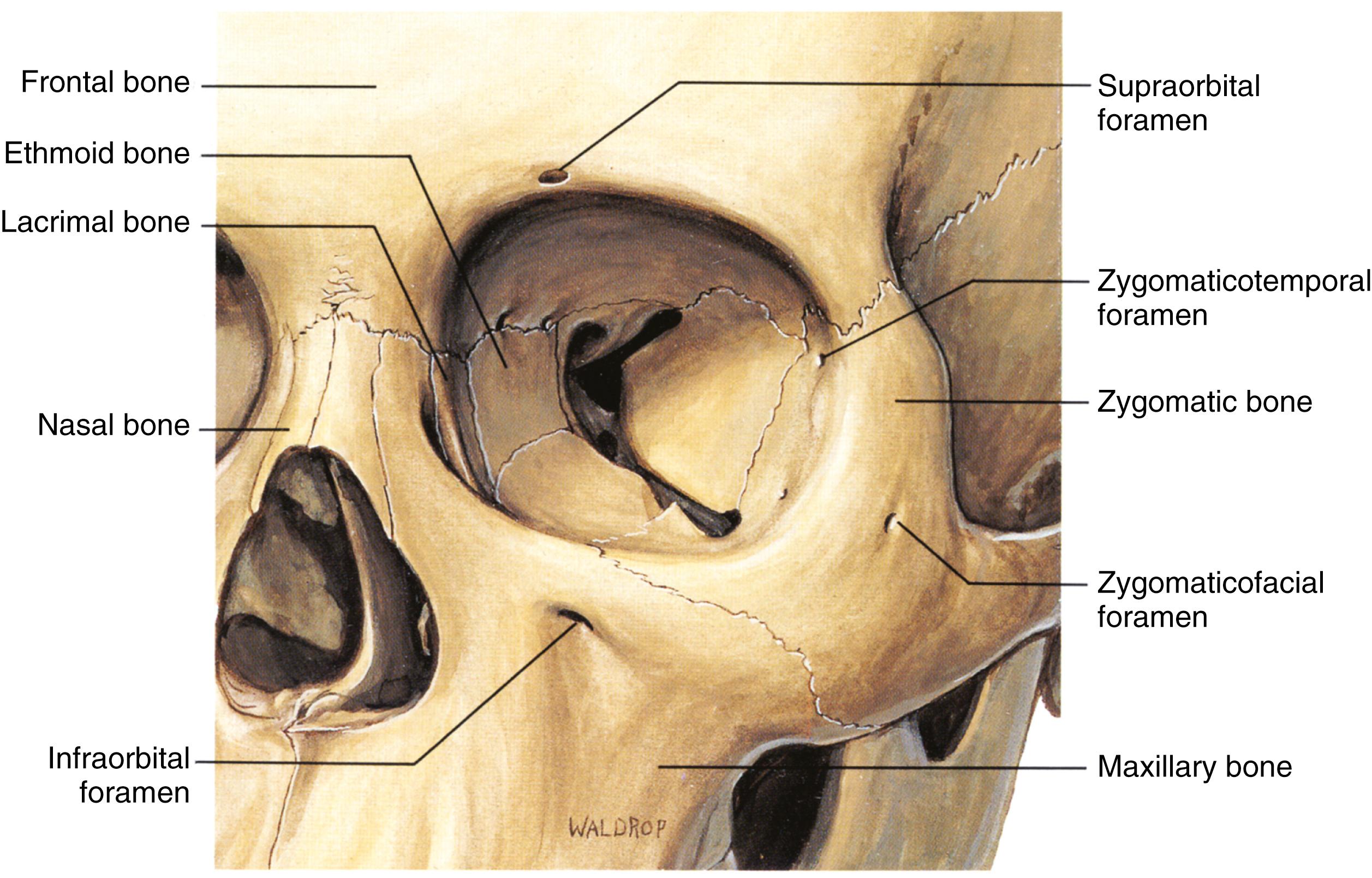
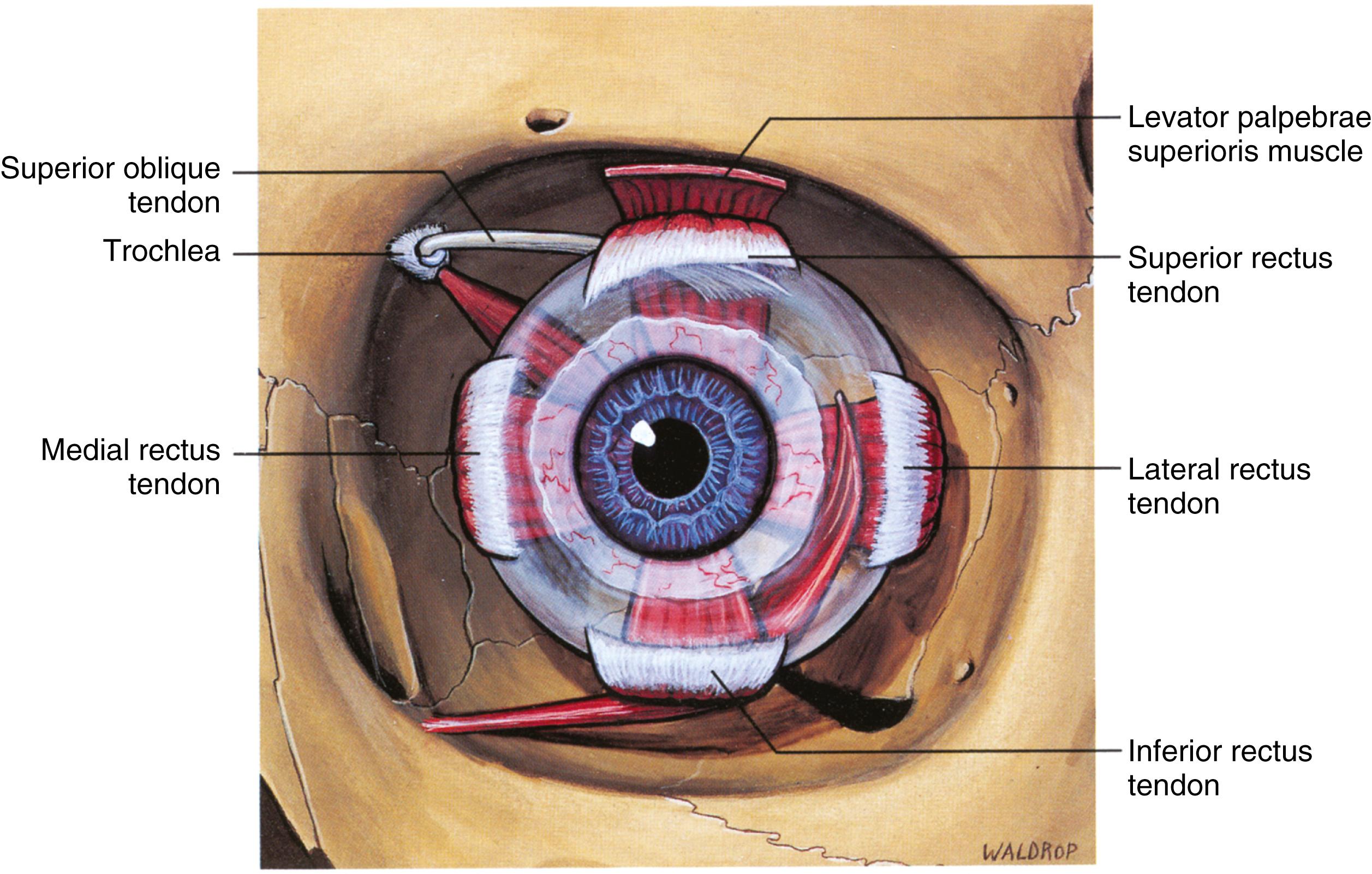
Most fractures involving the bones of the orbit occur because of blunt trauma to the face. Penetrating trauma, such as that caused by a projectile, is less common. Consideration of the probable velocity (momentum and direction) of the inciting object will often give clues to the likely location and severity of the bony involvement. For example, true blowout fractures are frequently the result of low-velocity trauma to the orbit, such as a thrown baseball, whereas a motor vehicle collision or being struck by a baseball bat in the face (high-velocity trauma) may cause a displaced zygomaticofacial complex (ZMC) or Le Fort–type fracture.
Most diplopia will resolve without surgical intervention; this is usually not an initial sole indication for surgery.
Clues to muscle entrapment include the age of the patient, small fracture size, severe pain on attempted duction, severe limitation of upgaze, and nausea and vomiting ( Figs. 187.3 to 187.5 ). Traction on the inferior rectus is thought to activate the oculocardiac reflex (bradycardia, hypotension, and vomiting) and could theoretically be fatal. In addition, the muscle is compressed and quickly becomes ischemic, thereby rapidly leading to irreversible scarring and permanent diplopia.
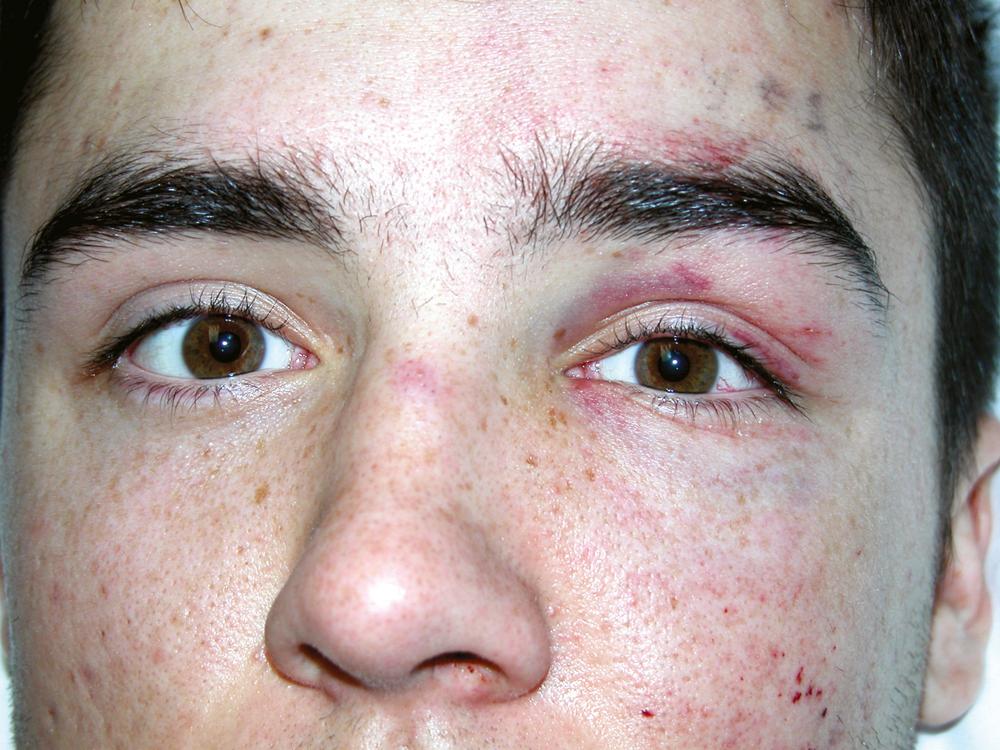
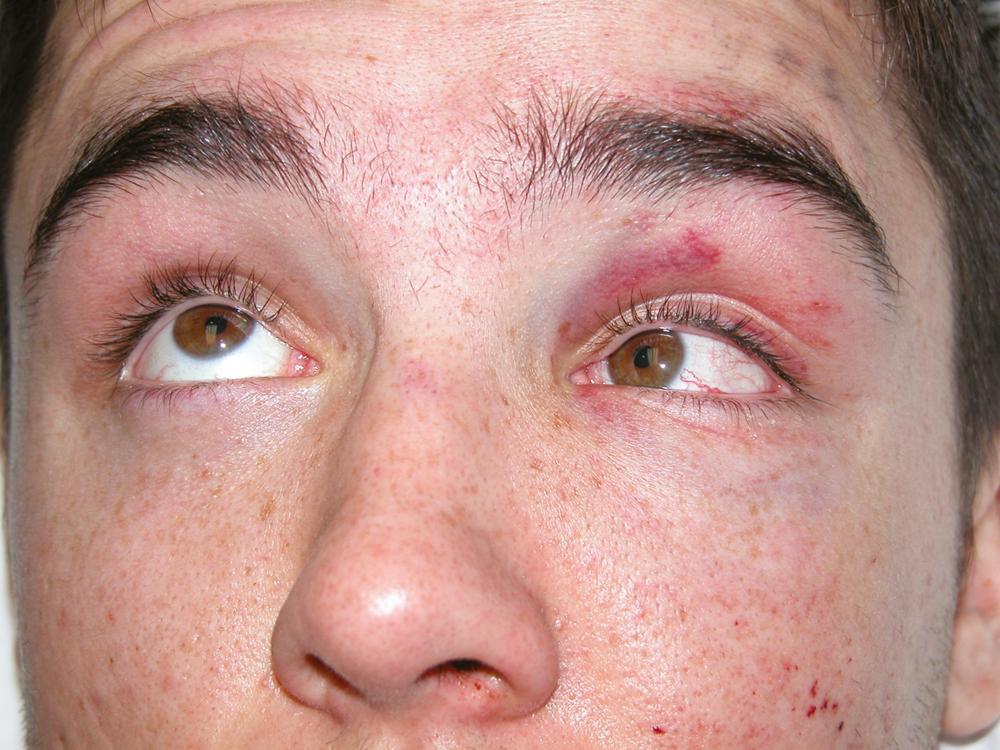
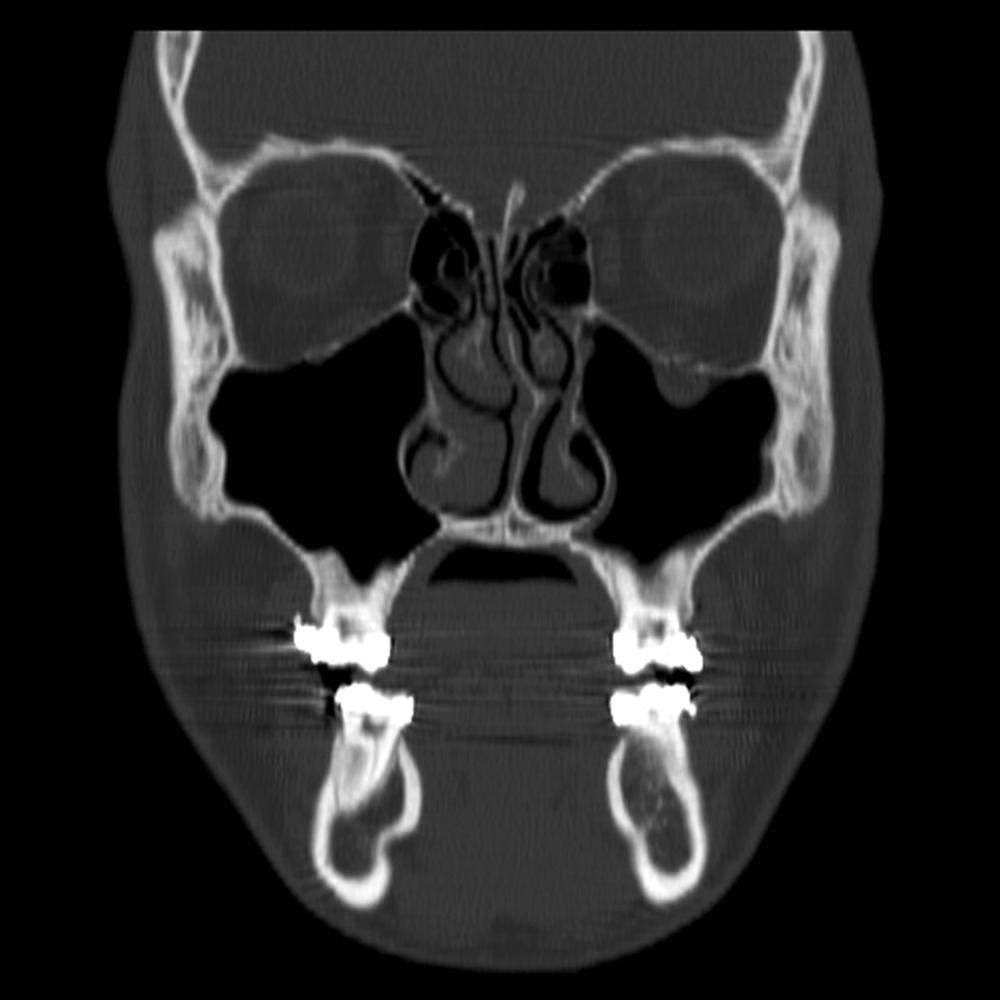
Most orbital fracture repairs can be delayed for 7 to 14 days, so consideration of the status of the rest of the patient must be undertaken immediately. The usual trauma evaluation, including establishment of the airway, breathing, and circulation, is performed first. A secondary survey will then uncover less urgent issues, including facial fractures. Delayed repair allows stabilization of the patient, full evaluation of the impact of the injury, and attention to more urgent issues (e.g., decompression craniectomy). However, in some instances, fracture repair will be undertaken more urgently because of intercurrent issues, such as an intractable cerebrospinal fluid leak.
Evaluation of the severity of the fracture must include attention to the orbital contents. A basic eye examination can be performed even on a comatose patient by using a penlight and pair of toothed forceps. In most major trauma centers, an Ophthalmologist is available on call to evaluate the eye and periocular area, which is the safest way to ensure that no occult injury is overlooked. In other emergency rooms, the Otolaryngologist will need to at least document vision, and if possible, pupillary reactions, eye movements, and appearance of the eye.
Mechanism of injury
Previous eye/orbital surgery
Other injuries
Other illnesses/medications (Only in the most urgent circumstances, e.g., an entrapped extraocular muscle, should surgery be undertaken with the patient on anticoagulation.)
Vital signs
Examination of the eye by an Ophthalmologist is strongly recommended when an orbital fracture is suspected.
Vision (in each eye separately)
Ductions movements of eyes in all directions volitionally, or forced, by the examiner with toothed forceps
Enophthalmos/exophthalmos (measure with a Hertel or other exophthalmometer if possible)
Existing lacerations, lids malposition, or scars
Other associated soft tissue injuries
Fine cut orbit or maxillofacial computed tomography (CT) without contrast with coronal plane reconstruction
Type of fracture
Zygomatic maxillary compound fractures (ZMC)
Le Fort 2/3
Frontal
Naso-orbito-ethmoidal (NOE)
Blowout
Force applied to the lower midface region produces variations of the classic fracture patterns described by Le Fort. Rarely do Le Fort fractures occur precisely as he described or symmetrically; however, these divisions help guide repair and provide an orderly and predictable approach. Le Fort II fractures, discussed in more detail in Chapter 186 , traverse the maxillary sinus, orbital floor, medial wall, and nasal bones. Le Fort III fractures, also called craniofacial dysjunction, involve the zygomatic bones in the lateral orbital walls, the floor and medial orbital walls, and the nasal bones. Although an air-fluid level noted on CT in one maxillary sinus suggests a sinus or orbital fracture, when this sign is present in both maxillary sinuses, one must assume the presence of a Le Fort II or III fracture until careful examination has proved otherwise. All Le Fort fractures also cause some measure of malocclusion.
Application of significant force to the upper midface area can lead to telescoping nasal fractures and NOE fractures. The hallmark of these injuries is traumatic telecanthus, with the normal intercanthal distance being about 35 mm or less. Fracture lines generally travel posteriorly through the medial orbital walls. The most urgent issues with these fractures involve possible leakage of cerebrospinal fluid with associated meningitis and trauma to the brain and the possibility of involvement of the optic canals posteriorly. Careful consideration must be given to the urgent need for decompression. Repairing these fractures requires re-establishing the normal anatomic relationships of the medial canthi. These injuries are discussed further in Chapter 186 .
ZMC fractures involve force directed posteriorly over the malar eminence or zygomatic arch. They were formerly referred to as “tripod” fractures, but this term is not entirely accurate, because this bone articulates in five places, even though two of the five generally do not require fixation during reduction. The characteristic facial deformity of a displaced ZMC fracture is flattening of the malar eminence, with or without apparent enophthalmos, and difficulty opening the mouth completely.
The remaining fractures involving the orbit (fractures of an orbital wall without associated rim fracture) are referred to as blowout fractures. Smith and Regan first described them in 1957 after observing a patient who had been hit in the periorbital area by a hurling ball.
Size of fracture
If this is small and/or minimally displaced, surgery may not be indicated.
If there is a linear wall fracture, there is a risk of entrapment of an extraocular muscle or periorbita.
The first four types of fractures are covered in Chapter 186 .
Entrapped extraocular muscle mandates immediate open reduction internal fixation.
Large (>2 cm 2 ) or displaced fractures should be offered repair to treat/prevent enophthalmos, NOT to prevent diplopia (which will almost always resolve on its own).
It is generally accepted that fractures involving more than 50% of the orbital floor are likely to cause later enophthalmos. Displaced fractures with an area of 2 cm 2 or greater are most significant: Approximately 1 cm produces about 1 mm of enophthalmos, and at a 2 mm or greater difference in projection of the globes, an aesthetic defect is noticed. The area of the medial wall fracture must be accounted for when making this rough calculation; although the medial wall is repaired less frequently, it contributes to later enophthalmos. A recent series of fractures of the orbital floor found that pediatric patients with large fractures who underwent surgery were much less likely to develop enophthalmos than their conservatively managed counterparts but that some children who presented with initial enophthalmos resolved over the following 6 months. In the pediatric population, it is acceptable to defer surgery except in patients with acute enophthalmos, muscle entrapment, or vertical dystopia.
Systemic comorbidity
Hyphema or traumatic optic neuropathy
Wait at least 5 days for hyphema to clear to prevent rebleeding.
Wait up to 6 months for traumatic optic neuropathy, which often improves on its own.
Frank infection in periorbital area or sinus
CT scan available
Decide what implant material to use and how/whether to fixate.
Become a Clinical Tree membership for Full access and enjoy Unlimited articles
If you are a member. Log in here